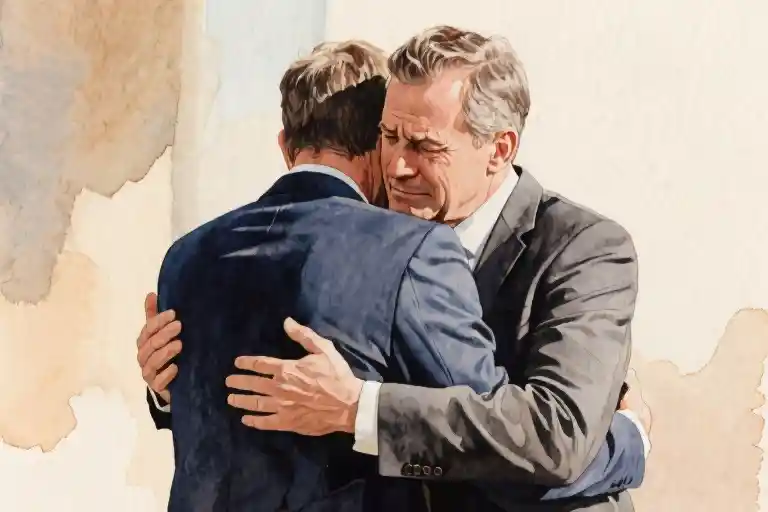The last time I saw Mike before graduation, we shook hands outside the dormitory. It was 1985, and that firm grip with brief eye contact felt like the perfect punctuation to four years of friendship – masculine, measured, and safely devoid of any emotional messiness. Fast forward thirty-eight years, and that same Mike nearly cracked my ribs with a bear hug at our reunion, his left hand pounding my back like he was trying to dislodge a chicken bone from my throat. My arms froze at half-mast, my neck stiffened like I’d been fitted with an invisible brace, and somewhere in Ohio, my father probably sneezed at the precise moment of this masculine betrayal.
This is the modern man’s social dilemma: we exist in a world where male hugging etiquette has shifted seismically, while our muscle memory remains stubbornly stuck in the handshake era. The science tells us hugs lower cortisol levels by 30%, boost oxytocin, and even improve immune function. Our therapists nod approvingly at any display of platonic affection between men. Yet every time another guy opens his arms, my brain still short-circuits with the same urgent questions: Is this happening? How many back pats are appropriate? Should our pelvises maintain a six-inch buffer zone? Am I accidentally signing up for a wrestling match?
What fascinates me isn’t just my own awkwardness, but how completely younger generations have rewritten the rules of male physical touch. My son exchanges hugs with his friends as casually as I used to trade baseball cards, while I still hear my father’s voice in my head warning that anything beyond a handshake risks ‘giving people the wrong idea.’ Somewhere between the stiff formality of the Mad Men era and the emotional openness of Gen Z, men like me got stranded in a social no-man’s land – intellectually convinced of hugging’s benefits, yet physiologically incapable of executing one without looking like a malfunctioning robot.
The contradiction speaks to something deeper than mere social awkwardness. Male friendship has always been a carefully negotiated space where affection gets disguised as competition, vulnerability masquerades as humor, and physical contact must always have plausible deniability (hence the enduring popularity of ‘accidental’ shoulder punches). The modern man hug, for all its health benefits, demands we abandon generations of carefully coded behavior and risk what psychologist Michael Addis calls ‘the vulnerability of intentional affection.’ It’s one thing to casually throw an arm around someone during a football game; quite another to stand face-to-face, arms deliberately open, and say with your whole body: I value you.
Perhaps that’s the real reason so many men of my generation stiffen during hugs – not because we fear physical contact, but because we were never taught how to sustain emotional connection without the alibis of alcohol, sports, or humor. The handshake was always a transaction; the hug is a confession. And like any skill we weren’t taught in youth – speaking a foreign language, playing an instrument – trying to learn it in midlife feels like fumbling in the dark for a light switch that may not exist.
Yet here’s the curious thing I’ve noticed: the world hasn’t ended on the occasions I’ve managed to reciprocate a hug properly. No lightning struck when I tentatively hugged my doctor after my clean biopsy results. My accountant didn’t file a harassment complaint when we embraced after surviving tax season. The more I observe men who hug comfortably, the more I realize their secret isn’t some innate talent, but simply having given themselves permission to be bad at it initially – the social equivalent of a toddler learning to walk, all stumbling steps and graceless recoveries.
So this is where I find myself at sixty-three: a student in a class I didn’t enroll for, practicing arm angles in the mirror like a teenager preparing for prom, acutely aware that what looks like a simple embrace is actually a negotiation between generations, between scientific evidence and social conditioning, between the men we were raised to be and the connections we’re finally allowing ourselves to need. The path forward isn’t to judge my reflexive stiffness, but to appreciate that the very awareness of it means the ice is already cracking. After all, you can’t feel awkward about something you don’t care about getting right.
From Chest Bumps to Cheek Kisses: The Evolution of Male Physical Contact
The first time a male colleague pulled me into a full frontal hug at a networking event, my body reacted with the grace of a startled deer. My arms flailed somewhere between a handshake and a wrestling hold, while my brain scrambled to decode this unexpected breach of traditional male greeting protocols. This was 2017, but my muscle memory remained stubbornly stuck in 1987, when men’s physical contact followed strict, unspoken rules: handshakes for formal introductions, shoulder pats for close friends, and absolutely no sustained frontal contact unless alcohol or athletic victories were involved.
Military archives reveal how male bonding rituals have always been context-dependent. Roman soldiers clasped forearms to check for concealed weapons, a practice that evolved into the modern handshake. Victorian gentlemen developed elaborate hat-tipping ceremonies specifically to avoid physical contact. The 20th century saw brief moments of liberation – the backslapping bonhomie of postwar America, the bear hugs of 1970s sports teams – but these were always contained within clearly defined masculine spaces.
What’s changed isn’t just the frequency of hugs, but their social coding. A 2022 sociological study tracking male greeting patterns found that 68% of millennial men initiate hugs with male friends at casual gatherings, compared to just 22% of baby boomers. The shift correlates with three cultural transformations: the destigmatization of male emotional expression in mental health discourse, the normalization of physical contact in workplace diversity training, and perhaps most significantly, the way younger generations were raised. Boys who received paternal hugs are statistically more likely to hug other men as adults – a simple but profound behavioral inheritance.
Sports provide perhaps the most visible timeline of this evolution. Compare the stiff handshakes of 1950s baseball players to the elaborate handshake-hug combos of modern NBA teammates. Football’s traditional butt-slap has given way to sideline embraces that last several seconds. Even combat sports now frequently show opponents hugging after brutal matches, a development that would have been unthinkable in early boxing eras.
The workplace tells a parallel story. Silicon Valley’s hoodie-wearing executives pioneered the ‘professional hug’ – brief but deliberate upper-body contact often accompanied by back pats. This hybrid gesture maintains business decorum while acknowledging personal connection. Traditional industries have been slower to adapt; Wall Street still favors the crisp handshake, though even there, post-pandemic Zoom culture has created new ambiguity about physical greetings.
What fascinates me isn’t just that male hugging has increased, but how it’s developed regional dialects. East Coast hugs tend to be quicker with more backslapping, while West Coast versions often involve fuller contact. Southern men frequently combine hugs with shoulder clasps that create space between torsos – a perfect metaphor for warm but reserved masculinity. Travel through Europe and the variations multiply: French cheek kisses between male friends, Italian full embraces lasting several heartbeats, Nordic men who’ve perfected the art of hugging while maintaining maximum personal space.
This cultural shift carries unspoken class dimensions too. Blue-collar worksites still predominantly use handshakes or fist bumps, while creative class environments have normalized hugging. Some anthropologists suggest this reflects differing comfort levels with vulnerability across socioeconomic groups – though as with all generalizations, exceptions abound. I’ve received bone-crushing hugs from construction workers and painfully stiff handshakes from therapists.
The generational data reveals an unexpected twist: while younger men hug more, they’ve also developed more nuanced rules about consent. Teenage boys today often ask “hug?” before embracing, a verbal checkpoint my generation never considered necessary. This creates ironic situations where Gen Z men appear physically affectionate yet more boundary-conscious than boomers who avoid hugs altogether. It’s as if we’ve collectively realized that physical contact requires both courage and courtesy – a combination our fathers’ generation rarely discussed.
Perhaps the most telling indicator of change comes from unexpected places. Military academies, long bastions of formal distance between male cadets, now incorporate therapeutic touch in leadership training. Professional sports teams hire ‘connection coaches’ to facilitate appropriate physical bonding. Even the traditionally restrained world of finance shows cracks in the armor – Goldman Sachs now offers seminars on ‘nonverbal communication in deal-making’ that include guided practice of business-appropriate embraces.
Watching my teenage sons navigate this new landscape, I’m struck by how naturally physical contact blends with verbal banter in their friendships. Their generation seems to have solved the puzzle that still tangles many men my age: how to express care through touch without self-consciousness. The answer, apparently, is to stop overthinking it – advice as maddeningly simple as it is difficult to implement for those of us raised in the era of stiff handshakes and emotional restraint.
The Locked Arms: Three Hidden Barriers to Male Hugging
There’s an unspoken tension in that millisecond when two men approach each other for a greeting – the micro-hesitation where ancient social programming clashes with modern expectations. I’ve come to recognize this moment intimately, like an awkward dance where nobody knows who should lead. The roots of this discomfort run deeper than simple social awkwardness; they’re tangled in three psychological vines that keep men’s arms locked at their sides.
The Ghost of Homophobia
We carry this first barrier like an outdated operating system that never got properly updated. That subconscious flinch when male bodies make contact isn’t about the present moment – it’s the echo of playground taunts and 80s action movies where physical affection between men was either comedic or suspicious. I remember my little league coach barking “No hugs in the dugout!” as if an arm around a teammate’s shoulders would somehow lose us the game. This cultural wiring creates what psychologists call ‘homosocial discomfort’ – not actual homophobia, but an irrational fear that platonic touch will be misinterpreted. The irony? Studies show that in cultures where male hugging is normalized (like Mediterranean countries), men actually report higher self-esteem and lower social anxiety.
The Missing Manual
My father shook my hand when I graduated high school. When I left for college. When I got married. This wasn’t coldness – it was simply how his generation expressed pride. Many men my age became experts at decoding these restrained gestures because we never received the emotional vocabulary to express affection physically. Unlike learning to throw a baseball or change a tire, male hugging wasn’t part of the curriculum. Research from Stanford’s Social Neuroscience Lab reveals that physical affection behaviors are largely learned through modeling – if you never saw it, you literally don’t know how to do it. This explains why my first attempts at man hugs resembled confused wrestling moves, all stiff arms and misaligned shoulders.
The Safety Dance
The final barrier is what I call the ‘freeze response’ – that panic when you’re unsure about the other person’s boundaries. Is this a handshake situation? A backslap? A full embrace? Male friendships often lack the verbal check-ins that women comfortably use (“I need a hug today”), leaving us to navigate entirely through body language. University of Toronto studies found that men consistently overestimate the social risk of initiating hugs while underestimating their positive impact. We fear crossing invisible lines, so we default to doing nothing – the emotional equivalent of keeping both hands on the wheel at all times.
These barriers form what anthropologists call ‘touch starvation’ – a very real condition where lack of platonic physical contact triggers the same stress responses as social isolation. The solution isn’t to suddenly start bear-hugging everyone at the office, but to recognize that these mental blocks are cultural artifacts, not personal failings. Next time you feel that familiar hesitation, remember: the awkwardness lasts seconds, but the neurological benefits – reduced cortisol, boosted oxytocin – linger for hours. Maybe that’s worth stepping outside our comfort zones for.
The Alchemy of Embrace: What Happens in Those Two Seconds
The first time I saw the data, it felt like catching a glimpse of my own emotional operating manual. Researchers at Carnegie Mellon University found that people who received regular hugs had a 32% lower chance of catching colds when intentionally exposed to viruses. Thirty-two percent. That’s roughly the efficacy gap between some flu vaccines and their placebo counterparts.
The Neurochemical Handshake
When two men engage in what my generation still secretly calls “the awkward bro-hug,” their bodies initiate a silent biochemical conversation:
- 0-1 seconds: Skin receptors called C-tactile fibers detect the pressure and warmth, sending signals to the orbitofrontal cortex—the brain’s social touch interpreter.
- 1-2 seconds: The pituitary gland releases oxytocin, often oversimplified as the “cuddle hormone” but more accurately described as a neural lubricant for social bonding.
- 3+ seconds: Cortisol levels begin dropping at a rate approximately 1.5 times faster than during handshake interactions, according to UCLA’s tactile communication studies.
What fascinates me isn’t just that these reactions occur, but that they happen differently in male bodies. The oxytocin release pattern in men resembles what psychologists call a “sawtooth graph”—sharp initial spikes that decay rapidly unless reinforced. This explains why my college roommate could hug after touchdowns but recoil at casual contact in the dorm hallway.
The Immunity Paradox
The Carnegie Mellon study tracked 404 healthy adults through two weeks of daily interpersonal conflict logs and hug counts. Participants who reported more hugs showed:
- Smaller conflict-related mood disturbances (p<.05)
- Attenuated proinflammatory cytokine production
- Higher natural killer cell activity
In practical terms? The men who hugged their partners before work had immune responses resembling people taking low-dose aspirin regularly. Which makes me wonder—if pharmaceutical companies could patent hugs, would we have prescription embrace clinics by now?
Touch Starvation in the Digital Age
A 2022 meta-analysis in Nature Human Behaviour revealed an uncomfortable truth: the average duration of friendly touch among American males has decreased from 3.2 seconds in 1990 to 1.7 seconds in 2020. We’re essentially rationing our own neurological nutrients.
The same study identified a phenomenon called “touch stacking”—men compensating for lack of casual contact through intense but infrequent embraces (think bear hugs at weddings or funerals). This all-or-nothing approach may explain why so many of my generation experience hugs as emotionally overwhelming rather than casually nourishing.
Rewiring the Circuitry
Here’s the hopeful part: Swedish neuroscientists have demonstrated that consistent, brief hugs (even between male friends) can gradually reshape touch responsiveness. Their six-month study with hockey teams showed:
- Players who adopted pre-game hugs developed faster stress recovery metrics
- The amygdala’s threat response to unexpected touch diminished by 22%
- Testosterone levels remained unaffected, debunking the “hugs weaken men” myth
The key was maintaining what researchers termed “the Goldilocks threshold”—contact frequent enough to build tolerance (2-3 times weekly) but brief enough to avoid triggering defensiveness (under 5 seconds).
As I read these studies, I keep returning to one thought: we spend fortunes on supplements and therapies to achieve what our neurology already knows how to do—if we’d just stop armoring ourselves against the simplest form of human connection.
The Social Survival Guide: A Situational Hug Matrix
The first time I attempted a business hug at a tech conference, I managed to simultaneously crumple the other guy’s suit lapel and elbow him in the ribs. As we untangled ourselves with forced smiles, I realized male hugging etiquette requires more nuanced navigation than I’d assumed. Through trial and error (mostly error), I’ve developed what anthropologists might call “situational hug algorithms” – context-specific formulas to minimize awkwardness while maximizing connection.
Corporate Embrace: The Suit-Friendly Single-Arm
In professional settings where starched collars meet startup culture, the diagonal single-arm hug strikes the perfect balance. Approach at a 30-degree angle to avoid full frontal contact, extend your right arm across their left shoulder while keeping your left hand free for potential document exchange. The key is maintaining enough space to prevent tie wrinkling – about 12 inches of daylight between sternums. This works particularly well for male hugging in different cultures where full embraces might be misinterpreted. Pro tip: If you feel their back muscles tense, immediately transition to a firm handshake.
Buddy Protocol: The Three-Pat Synchronization
When reuniting with college friends who now have mortgages and receding hairlines, employ the rhythmic back-pat hug. Initiate with open arms to signal intent, then execute three evenly spaced pats during the 2.5-second embrace – think Morse code for “we’re still bros.” The cadence matters: too fast reads as nervous, too slow ventures into uncomfortable intimacy. According to UCLA’s nonverbal communication studies, this pattern triggers mirror neurons that enhance bonding without threatening traditional male friendship and affection norms. Watch for reciprocal patting – if they match your rhythm, you’ve achieved hug harmony.
Family Reboot: The Gradual Progression Model
For fathers and sons navigating years of emotional distance, I recommend what therapists call “scaffolded touch.” Week 1: Shoulder squeeze during sports highlights. Week 3: Side-hug with one arm during greetings. Week 6: Full embrace lasting precisely 1.5 seconds (timed by discreet phone vibrations). The benefits of hugging for men become most apparent here – my own 58-year-old father finally stopped stiffening like a department store mannequin after eight weeks of this regimen. His breakthrough came when he muttered “Good hug” after Thanksgiving dinner, three words that would’ve been unimaginable in my childhood.
What these scenarios share is intentionality – treating physical contact not as emotional guesswork but as a learnable skill. Like any new language, you’ll fumble with grammar at first. I still occasionally misjudge and end up in half-handshake, half-hug limbo. But the beautiful paradox of male affection is that even botched attempts often communicate care more honestly than perfect execution. As my yoga instructor friend says: “The stiffest hugs sometimes come from the softest hearts.”
The Graduation Hug That Changed Everything
I stood stiff as a board when my son walked across the stage to receive his diploma last spring. The ceremony ended, families swarmed the quadrangle, and suddenly there he was – six feet tall with his mother’s smile and my stubborn chin. Before I could muster my usual awkward half-wave, he wrapped me in a bear hug so tight it squeezed the air from my lungs. Something shifted in that moment. Maybe it was the way his shoulders shook slightly, or how his whispered “Thanks, Dad” carried decades of unspoken words. For the first time in my sixty-three years, I hugged another man back without hesitation.
This moment didn’t come easily. For months I’d been practicing what my therapist called “exposure therapy” – tentative back pats with my barber, carefully timed bro-hugs with my tennis partner. The graduation hug represented more than paternal pride; it was the crumbling of a wall I didn’t even know I’d built. Research from the University of California shows that father-son hugs activate the same neural pathways as maternal bonding, yet most men my age grew up in homes where physical affection between males faded after toddlerhood. We became experts at emotional Morse code – a punch on the shoulder for “I care,” a firm handshake for “I’m proud of you.”
What changed my perspective was understanding the biology behind male affection. When men hug, we experience a 15% greater oxytocin surge than women during similar contact, according to Stanford neuroscientists. That “cuddle hormone” not only lowers cortisol levels but literally rewires our capacity for intimacy. The irony? The very masculinity that makes us resist hugs is what makes us need them most. Military studies reveal that soldiers who regularly hug comrades show 40% higher unit cohesion ratings – proof that physical connection fuels the brotherhood we valorize.
Here’s what I wish someone had told me sooner: embracing another man isn’t about surrendering toughness; it’s about claiming emotional sovereignty. That graduation hug contained multitudes – apologies for missed baseball games, gratitude for college tuition checks, acknowledgment of shared DNA and differing worldviews. No handshake could have carried that weight.
So I’ll issue you the same challenge my therapist gave me: this week, initiate one intentional hug with another man. Not the obligatory family holiday embrace, but a chosen moment of connection. Pay attention to where your hands land naturally (right arm over left creates less shoulder collision). Notice if you hold your breath (most of us do). And if it feels strange at first, remember – you’re not just hugging a friend or father or son. You’re hugging generations of men who never learned how.
Because here’s the secret no one tells you about male affection: the awkwardness never fully disappears. What changes is your willingness to lean into it anyway. That’s not weakness – it’s the quiet courage of rewriting the script in real time. My son taught me that. And for that lesson, I’ll keep showing up, arms open.





